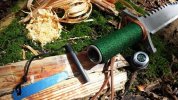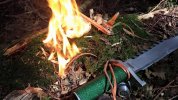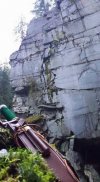Love the photo of your bird trap, Kevin: Particularly the unwrapped knife... The Rambo cliff shot is great, and the first nice overall shot I have ever seen of it... My first thought is we have to get a bunch of hollow handle nuts together to go to Hope BC!
I just found this interesting site for Timberline knives:
http://www.timberlinecollectors.com/
If you look into the catalogue, you will find in it the explanation of how the Timberline/Neeley/Sanders knives are assembled: Apparently a big 3/4" cylinder of solid brass is fitted around the blade's 5/8" broad tang (all the tang's inner and outer "corners", in section and in profile, are fully radiused for strength), the cylinder pressing the guard in place: Beyond that section of tang, and thus the brass cylinder, the tang narrows again to a short 5/16" wide section that is threaded fully round for a big steel nut (visible inside the handle), which nut holds the brass cylinder and the guard tightly against the blade: The outer section of the brass cylinder is fully threaded, and the tough 304 steel handle tube is then screwed into place around it.
The use of the solid brass cylinder is brilliant, because the brass will not transmit the same frequency of vibration, and will dampen shocks, instead of cracking the steel around it... It otherwise shows some similarities to the method used on the Martin knives, although on those the handle tube is screwed directly to the tang.

Except for the sharpness (very open angle main edge I'm afraid -around 25-30° per side-, but fixable with some effort, as you can see above where it is now well below 15°), this is in my opinion simply the most brilliantly designed, and executed, Hollow Handle Survival Knife of them all (a close contender would the RJ Martin with the reversed Parrish sawteeth that I posted before, with its axe-like chopping false edge, but that one is quite a bit bulkier... I also like the handle of the Hibben Rescue as well): The main reason I say this is that a close examination of the Neeley sawteeths reveals there is no way any other sawback can even come close to the sawing performance of the Timberline style sawback, especially on the full lenght 9.5" version above: 5.17" just for the saw's 16 teeths alone... I looked at close ups of the Liles (including the movie's #5!), and I am sure the Neeley/Timberline saw is superior in function because of some small, hard to photograph, design details: The saw's upper corners are made extra-sharp because the top surface of the Neeley teeths are slightly
hollow laterally across the spine: An incredible feat of grinding precision, given that each teeth top is slightly angled, meaning they could not be ground together in one shot...: In addition, all the sawteeth edges, in
every direction, are also dead-crisp: No rounding near the corners, of any kind, is even detectable, and the back edge of each teeth is actually viciously sharp as a result (fortunately, the angle is shallow enough to prevent too much aggression on the leather)...
If it wasn't for the low intial main edge sharpness, and especially the thick edge geometry (which is still similar to my hugely sharpened TOPS Hellion at 1.8 mm, despite much thinning), this knife would simply be from another planet entirely: I feel the saw alone is worth the price of admission...
I though the great leather sheath rubbed on the edge, but this turned out to be a false impression: The rubbing is actually on the secondary grind line, way up the blade... I've said it before, but it is worth saying again: This is the only fixed blade knife, with secondary grind lines, I have ever seen to be perfectly straight and symmetrical
on its secondary grind lines: When you see how even a Chris Reeves one-piece is ground on the secondaries, this borders on the unreal...
But after the battle of sharpening it, I still might buy another Randall, all medieval-style croockedness and all, because I fear that once my Neeley loses its great sharpness, that great edge would be very hard to restore, just because of the broad bevel it took to get there...
Gaston
















